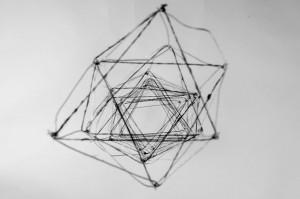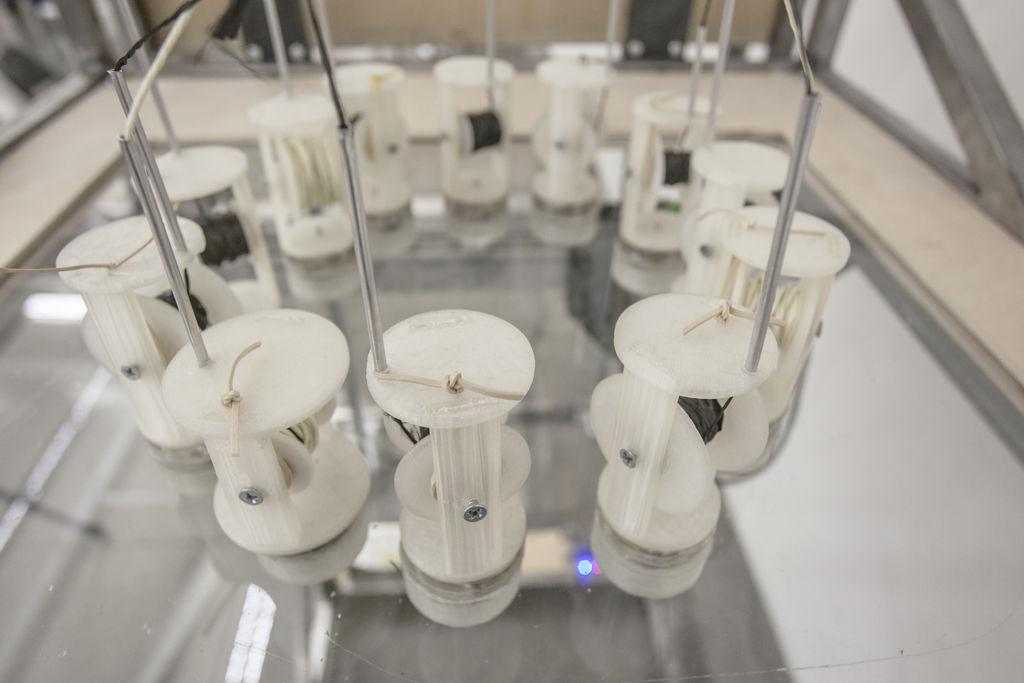One of the pivotal catalysts of the industrial revolution was the automation of textile manufacturing. Power looms in weaving sheds plus cotton and cheap labor equaled widespread availability and variety of fabric and, as we know it, unprecedented advancement. We think it’s fair to say that world-changing, technological leaps are being made currently and 3D printing is playing a central role in this 21st century high-tech revolution.
Three ingenious students at the California College of the Arts in San Francisco, Prerna Auplish, Evan Bowman, and Ryan Chen have brought together these two game-changing technologies, automated weaving and 3D printing, in their 3D weaving machine for their Creative Architecture Machines Advanced Studio course in CCA’s Digital Craft Lab under the guidance of their professors, Michael Shiloh and Jason Kelly Johnson of Future Cities Lab.
Bowman and Chen call their 3D weaving machine the “Space Weaver.” The machine creates super lightweight woven structures using fibrous materials. Space Weaver relies on a three-axis gantry (and kind of overhead mount or bridge support) system. It produces woven forms in a process similar to that of a 3D printer. Space Weaver is seven feet tall and uses carbon fiber and fiberglass to print woven structures up to five feet tall.
Chen and Bowman designed and built their 3D weaving machine over the course of a short, eight-week school session, refining as they went and testing materials after the building stage was completed. They welded the 84” x 32” x 28” frame using square tube carbon steel and 1” flat bar mounting tabs. While they explained that you don’t necessarily need to use steel for the frame, it does ensure rigidity, which is crucial to CNC (computer numerical control, the on-board computing that oversees the automation process) accuracy. The 17 ½” x 19 ½” glass print bed or build plate is exposed to, noted the machine’s inventors, to “emphasize the importance of the printed objects.” The exposure also allows them to service that portion of the Space Weaver easily.
The two students carefully documented their process and you can read their step-by-step instructions for building a Space Weaver on their In structables blog. They describe the various materials they use to construct the 3D weaving machine as well as methods for creating proper balance — for instance, concrete-filled water bottles allowed Bowman and Chen to “tune and adjust the counterweight.”
structables blog. They describe the various materials they use to construct the 3D weaving machine as well as methods for creating proper balance — for instance, concrete-filled water bottles allowed Bowman and Chen to “tune and adjust the counterweight.”
Chen and Bowman researched CNCs most suited for automated weaving and settled on a standard Shapeoko 2 CNC. They did have to make some adjustments, including adding or extending parts, that they explain in their how-to blog. The Space Weaver uses a total of five stepper motors and all are driven by a Synthetos V8 TinyG and a 24V 6.35 power supply, which are encased in a laser-cut acrylic case for protection. Chen and Bowman emphasized how important proper wiring and mounting are as “troubleshooting becomes complicated with a machine this size.” Going back in and fixing or redoing something after the machine is built will likely cause you considerable angst, so triple checking your work is a must. In the interest of additional safety and melt-down prevention, Chen and Bowman installed a remote control emergency stop switch just in case something started to go seriously awry.
The two design students worked through a variety of challenges related to spool design. Most involved issues related to reducing tension during the weaving-printing process. The spools themselves were 3D printed with PLA on a Flash Forge printer and they each have a three-layer, laser-cut acrylic base.

How do they make it weave, put those spools to proper use, though? They used a Synthetos TinyG four-motor control board (not open source) that converts G-code (the most commonly used numerical control programming language) into machine code. They control the stepper motors by sending the G-code to the TinyG from Grasshopper/Firefly (free plug-ins for Rhino). The students actually created a new programming method for translating the movements of the spools into actual woven forms and you can access their step-by-step pdf through the Instructables site.
Space Weaver is not bereft of overall aesthetic appeal either. Chen and Bowman explained that the tower design itself was inspired by ex isting structures — in particular, the Eiffel Tower in Paris and Canton Tower in Guangdong, China. They created the tower design in Rhino but they added, “Ideally, there would be a library of scripted moves that users could link together to create unique designs and structures of various strengths/transparencies.”
isting structures — in particular, the Eiffel Tower in Paris and Canton Tower in Guangdong, China. They created the tower design in Rhino but they added, “Ideally, there would be a library of scripted moves that users could link together to create unique designs and structures of various strengths/transparencies.”
After construction of the Space Weaver was completed, the two very detail-oriented students experimenting with a variety of resins, epoxies, and fibrous materials. They eventually settled on Zap CA Super Glue, which they use to saturate and cover the fibers of the woven structure, thus fixing it firmly. In terms of fibers, they went with .062” DIA fiberglass thread and 3K twisted carbon fiber tow (both purchased on EBay).
Eight weeks is a relatively short amount of time for designing, constructing, and refining a machine as complicated as Space Weaver, so Bowman and Chen felt they needed much more time to test processes. Their early results are, well, underwhelming, but we expect that many hours of experimentation will yield some pretty impressive 3D woven structures and hope the two students will update us as they go.
Let us know your thoughts on this seven-foot tall machine over at the Space Weaver forum thread at 3DPB.com.
Subscribe to Our Email Newsletter
Stay up-to-date on all the latest news from the 3D printing industry and receive information and offers from third party vendors.
You May Also Like
3D Printing Financials: Fathom Struggles in Financial Quicksand During Critical Transition
Facing a year of key transitions and financial pressures, Fathom (Nasdaq: FTHM) has filed its annual report for 2023 with the U.S. Securities and Exchange Commission (SEC). The document outlines...
Latest Earnings Overview for Australian 3D Printing Firms Titomic and AML3D
Australian 3D printing manufacturing firms Titomic (ASX: TTT) and AML3D (ASX: AL3) reported their financial results for the period from July to December 2023, marking the first half of their...
3D Printing Webinar and Event Roundup: April 7, 2024
Webinars and events in the 3D printing industry are picking back up this week! Sea-Air-Space is coming to Maryland, and SAE International is sponsoring a 3D Systems webinar about 3D...
3D Printing Financials: Unpacking Farsoon and BLT’s 2023 Performance
In the Chinese 3D printing industry, two companies, Farsoon (SHA: 688433) and Bright Laser Technologies, or BLT (SHA: 688333), have recently unveiled their full-year earnings for 2023. Farsoon reported increases...

































